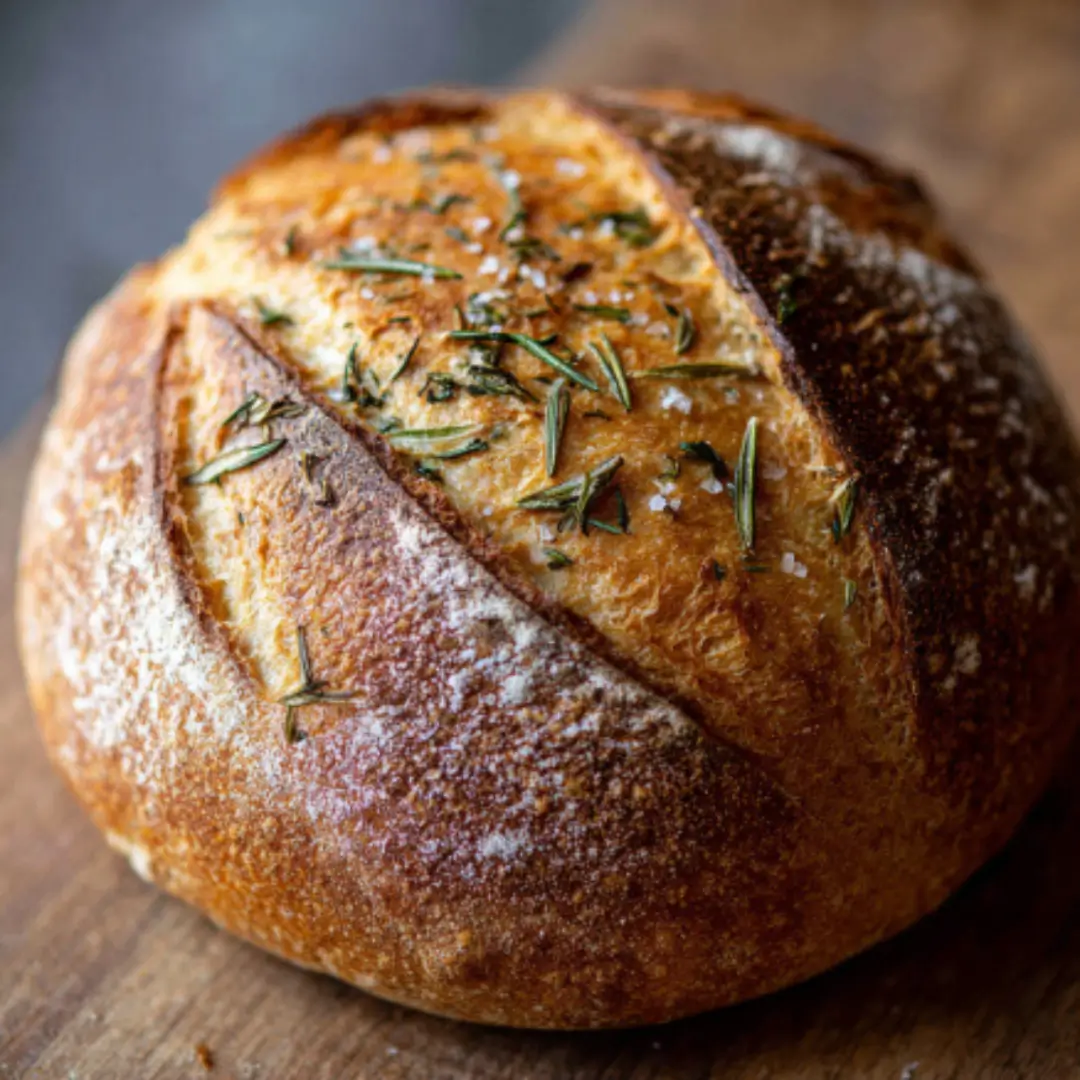When you bake your own bread at home, few things compare to the aroma and taste of rosemary sourdough bread fresh from the oven. This loaf offers a superbly crispy crust paired with a chewy, flavorful interior that’s infused with the fragrant herbal notes of fresh rosemary. It’s an artisan bread that elevates any meal or snack with its rustic charm and homemade goodness.
Why You’ll Love Making Rosemary Sourdough Bread
There’s something special about sourdough that captures the hearts of bread lovers everywhere. Unlike store-bought loaves, sourdough relies on natural fermentation to create complex flavors and textures you can’t find anywhere else. When you add fresh rosemary into the mix, it gives the bread an herbal twist that’s both earthy and fragrant.
You’ll appreciate the crisp crust that crackles satisfyingly as you slice through it, and the tender crumb inside that pulls apart easily without falling apart. This bread is more than just a side dish; it’s an experience. It invites you to slow down, enjoy the process, and savor every bite of your homemade creation.
Plus, by making this bread yourself, you control the ingredients, avoiding preservatives and additives common in commercial breads. The simple list of ingredients makes it approachable, yet the result feels gourmet. It’s an ideal bread for sandwiches, toasts, or simply dipping into olive oil and balsamic vinegar.
Ingredients for Rosemary Sourdough Bread
Before you get started, gather everything you need to make your rosemary sourdough bread come to life. Using high-quality ingredients will ensure the best flavor and texture.
- 5 cups all-purpose unbleached flour
- 1 1/2 cups lukewarm water
- 1 cup ripe sourdough starter
- 1 teaspoon instant yeast (increase to 2 teaspoons if your starter is less active)
- 3 to 4 tablespoons fresh rosemary, chopped finely
- 2 1/2 teaspoons sea salt
- Extra fresh rosemary and coarse salt (such as fleur de sel) for sprinkling on top
How to Make Rosemary Sourdough Bread
Making this bread may sound involved, but once you get the rhythm, it’s straightforward and incredibly rewarding. Follow these steps carefully to get that perfect crust and crumb.
Start by combining all your ingredients in a stand mixer bowl. Use the “2” bread setting and knead for 6 to 8 minutes until the dough feels smooth and elastic. If you don’t have a mixer, knead by hand for about twice as long — expect to spend around 12 to 16 minutes working the dough. The goal is to develop the gluten enough so the dough holds together well without being sticky.
Once kneaded, shape the dough into a ball. Lightly oil your mixing bowl and place the dough inside, turning it so the surface is coated with oil to prevent drying. Cover the bowl loosely with plastic wrap. Set it in a warm spot to rise for about 90 minutes, or until the dough doubles in size. This rise is when the yeast and starter activate, producing gases that puff the dough.
After the first rise, gently punch the dough down to release air pockets. Shape it into a round loaf. If you have a 10-inch banneton (a basket for proofing bread), place the dough inside it for the next rise; otherwise, use a comparable loaf pan. Cover it again and allow it to rise for about one hour until nearly doubled.
While the dough is proofing, preheat your oven to 425°F (220°C). If you have a baking stone, place it in the oven now so it can absorb heat. This helps create that crispy, well-cooked crust.
When ready to bake, invert the dough from the banneton onto the baking stone or sheet. Mist the dough lightly with water to help the crust form steam as it bakes. Using a long serrated knife or bread lame, make two diagonal slashes about half an inch deep across the top of the loaf. This allows steam to escape and gives the bread an artisan look.
Sprinkle extra rosemary and coarse salt on top for flavor and texture. Place the loaf in the oven and bake for 25 to 30 minutes. The crust should turn a deep golden brown and sound hollow when tapped on the bottom, indicating it’s fully baked.
Remove the bread and let it cool on a wire rack. Cooling lets the interior crumb finish setting, so resist the urge to slice it immediately. Once cooled slightly, slice and enjoy.
How to Serve Rosemary Sourdough Bread
You have a beautiful loaf of rosemary sourdough bread ready to enjoy — now let’s talk about the best ways to serve it.
Warm slices straight from the oven are unbeatable. The crust still crackles while the interior stays soft and chewy. Spread some butter or your favorite plant-based spread and savor the simple pleasure.
This bread also makes a fantastic base for sandwiches. Its sturdy crumb holds up well under fillings, whether you’re using fresh vegetables, cheeses, or roasted proteins. Try it with ripe tomatoes and mozzarella or a simple avocado and salt drizzle for an easy lunch.
Toasting slices brings out more of the rosemary aroma and adds a delightful crunch. Use it as a side for soups, stews, or salads. The herbal notes pair particularly well with hearty winter dishes.
If you’re feeling indulgent, turn the bread into grilled cheese sandwiches. The rosemary flavor complements melted cheese, and the crispy edges add texture.
For entertaining, cut the loaf into bite-sized pieces and serve with olive oil and balsamic vinegar for dipping. It’s a crowd-pleasing appetizer or snack that highlights the bread’s rustic qualities.
Expert Tips for Baking Rosemary Sourdough Bread
Perfecting sourdough bread takes practice, but these tips will help you get great results every time.
- Use an Active Starter: Your sourdough starter should be bubbly and ready to rise dough effectively. Feed it 4 to 8 hours before baking to boost its activity.
- Control Water Temperature: Lukewarm water helps activate yeast without killing it. Too hot or cold water can affect the rise.
- Knead Well: Proper kneading develops gluten, essential for bread’s chewy texture and structure. If kneading by hand, be patient and consistent.
- Long, Slow Fermentation: For best flavor, consider refrigerating the dough overnight after the first mix. This slow fermentation develops more complex sour notes.
- Scoring: Don’t skip scoring the dough. It controls how the bread expands and prevents unsightly cracks.
- Baking Stone: If you have one, preheat a baking stone in the oven. It helps create an even, crispy crust by radiating heat from below.
- Steam: Spraying water or placing a pan of water in the oven during baking can add steam, helping the crust develop a nice shine and crunch.
- Cooling: Let the bread cool completely before slicing to allow the crumb to set properly. Cutting too soon can make it gummy.
By following these simple but effective tips, you’ll elevate your rosemary sourdough bread from good to exceptional.
How to Store Rosemary Sourdough Bread
Keeping your bread fresh will let you enjoy it longer without losing texture or flavor.
Store your rosemary sourdough loaf wrapped in a clean kitchen towel or paper bag at room temperature. This protects the crust while allowing some airflow to prevent sogginess.
Avoid storing bread in plastic bags at room temperature, as trapped moisture makes the crust soft and chewy rather than crisp.
If you want to keep bread longer, slice it and freeze in an airtight container or resealable freezer bag. When you want to eat, toast slices straight from the freezer or thaw at room temperature.
To refresh slightly stale bread, warm it in the oven for 5 to 10 minutes at 350°F (175°C). This revives the crust and softens the crumb.
Variations to Try with Rosemary Sourdough Bread
Once you master the basic recipe, there are several tasty ways to customize your rosemary sourdough bread.
- Add Garlic: Mix minced garlic into the dough along with rosemary for a savory twist. Roasted garlic also works well.
- Olives: Incorporate chopped black or green olives for a Mediterranean flair.
- Cheese: Add shredded hard cheeses like Parmesan or aged cheddar into the dough for extra richness.
- Herb Mix: Try combining rosemary with thyme, oregano, or sage for varied herbal notes.
- Seeds and Nuts: Sprinkle sunflower seeds or chopped walnuts on top or knead them into the dough for texture.
- Whole Wheat: Substitute part of the all-purpose flour with whole wheat for a nuttier flavor and denser crumb.
Each variation lets you make the bread uniquely yours while keeping the fundamental sourdough qualities intact.
Frequently Asked Questions About Rosemary Sourdough Bread
What makes sourdough bread different from regular bread?
Sourdough uses natural fermentation with wild yeast and bacteria in the starter, giving it a tangy flavor and chewy texture without commercial yeast alone.
Can I make rosemary sourdough bread without a starter?
You can use instant yeast only, but the bread will lack the unique sourdough tang. The starter adds flavor complexity.
How do I know when the dough has risen enough?
The dough should roughly double in size and feel airy when gently pressed. It should not spring back quickly.
Why is my bread crust not crispy?
A hot oven and baking stone help crisp the crust. Also, adding steam in the oven by spraying water or adding a water tray can improve crust texture.
Can I use dried rosemary instead of fresh?
Fresh rosemary offers better flavor and aroma. If using dried, reduce the quantity and soak it in water before adding.
How long does rosemary sourdough bread stay fresh?
At room temperature, it’s best within 2 to 3 days. For longer storage, freeze slices.
Can I make the dough ahead of time?
Yes, refrigerate the dough tightly wrapped for up to 24 hours after the first mix. Bring it back to room temperature before shaping and baking.

Rosemary Sourdough Bread
Equipment
- Stand Mixer
- Banneton or Loaf Pan
- Baking Stone or Baking Sheet
- Serrated Knife or Bread Lame
Ingredients
- 5 cups all-purpose unbleached flour
- 1 1/2 cups lukewarm water
- 1 cup ripe sourdough starter
- 1 teaspoon instant yeast (increase to 2 teaspoons if starter is less active)
- 3 to 4 tablespoons fresh rosemary chopped finely
- 2 1/2 teaspoons sea salt
- Extra fresh rosemary and coarse salt for sprinkling on top
Instructions
- Combine all ingredients in a stand mixer bowl. Knead on the ‘2’ bread setting for 6 to 8 minutes until smooth and elastic.
- If kneading by hand, work the dough for 12 to 16 minutes until well developed.
- Shape the dough into a ball and place it in a lightly oiled bowl. Cover loosely with plastic wrap and let rise in a warm place for about 90 minutes, or until doubled in size.
- After the first rise, gently punch down the dough. Shape it into a round loaf and place it in a banneton for the second rise, covering it again for about one hour.
- Preheat the oven to 425°F (220°C) and place a baking stone or sheet inside to heat up.
- When ready to bake, invert the dough onto the baking stone. Mist lightly with water, then score the top with a serrated knife.
- Sprinkle with extra rosemary and coarse salt. Bake for 25 to 30 minutes until the crust is deep golden brown and sounds hollow when tapped.
- Remove the bread and let it cool on a wire rack before slicing.
Send me this recipe!
Just enter your email below and get it sent straight to your inbox!


